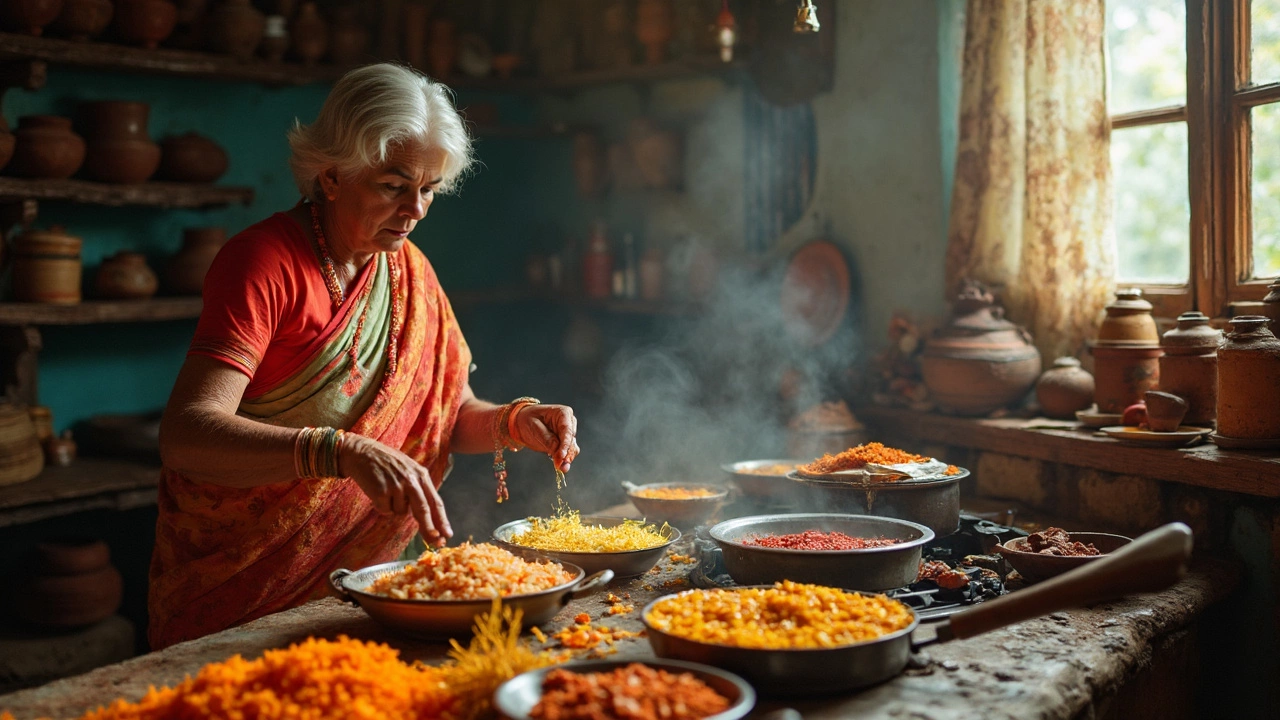If you've ever wondered what makes biryani such a flavorful delight, you're in for a treat. At its core, biryani is all about the right mix of ingredients and technique. Let's dive into what really gives biryani that irresistible taste.
First off, the spices. Biryani isn't biryani without its signature spice blend. Think whole spices like cloves, cardamom, and cinnamon mingling with garam masala or a touch of saffron. These aren't just flavor enhancers; they're the backbone of the dish. Each spice brings its own magic, and together, they create a symphony of flavors.
But spices alone don't do the trick. Ever noticed how the rice used in biryani is different? It's all about length and aroma. Good quality basmati rice is key. The grains stay separate, long, and fragrant, giving that perfect base for soaking up all the biryani goodness.
Essential Spices
So, what's the spice story behind a delicious biryani? Well, spices are where the magic starts, and for biryani, it's about getting the blend just right. You can't just throw things in and hope for the best. The art is in the balance.
Whole Spices
Let's kick off with the stars of the show—whole spices. There’s cloves, cardamom, and cinnamon. These little guys pack a punch. When they're tossed into hot oil, they release their aromatic oils, giving your biryani that warm and inviting aroma. Cloves add a bit of earthiness, cardamom lends sweetness, and cinnamon a hint of spice.
Ground Spices
Next up, ground spices like garam masala, turmeric, and red chili powder. Garam masala is the secret weapon for that rich and complex flavor profile. Turmeric brings the color, and chili powder brings the heat—and yes, a little chili is essential.
The Saffron Secret
Then there’s saffron. This isn’t just fancy talk—a few strands soaked in warm milk do wonders. Saffron lends a golden hue and an unmistakable scent that sets biryani apart from other rice dishes. It's pricey, but you don't need much, and it's worth it.
Pro Tip: Spice Storage
Here’s a quick tip: keep your spices fresh by storing them in airtight containers away from heat and light. Freshly ground spices always work best. Use them before they start losing their fragrance and strength, usually within six months.
Mix these spices right, and the soul of your biryani springs to life. It's all about proportion and timing. Now, isn't that spicy enough to get started?
Quality of Rice
When it comes to biryani, not all rice is created equal. If you're aiming for that authentic taste, opting for high-quality basmati rice can make all the difference. Seriously, the right rice is like the canvas for your biryani recipe.
Basmati is preferred because of its long, slender grains and aromatic essence. When cooked, it doesn't clump together, which is great because nobody wants a mushy biryani. Imagine long, perfectly cooked grains, each carrying a hint of those aromatic spices.
Buying Tips
- Look for aged basmati rice. It may cost a bit more, but age means better grain separation.
- Check the length. Longer grains are a good sign of quality.
- Always rinse your rice before cooking. It gets rid of excess starch, ensuring a fluffier biryani.
There are different grades of basmati, but grabbing one from a reputable brand typically paves the way to cooking success. Some basic rinsing and soaking goes a long way too.
Cooking the Perfect Rice
Now, here's a little-known fact: In some homes, biryani rice is partially boiled first. This parboiling method helps the rice absorb maximum flavor while ensuring it doesn’t get overcooked in the layers.
- Rinse and soak the rice for about 30 minutes.
- Boil with a bit of salt till it's about 70% done.
- Drain and let it sit before layering with your biryani mixture.
And if you're aiming to dazzle your guests with that restaurant-like fragrant biryani taste, consider adding a few drop of rose water or a couple of saffron strands soaked in warm water right before finishing it off in the oven or on the stove.

Cooking Method
The way you cook biryani plays a huge role in how tasty it ends up. It's not just about mixing things up; it's about layering flavors. The cooking process is where the magic truly happens.
Layering Technique
Biryani is known for its unique way of layering. Start by partially cooking the rice. You want the grains to be about 75% done. This ensures they absorb the flavors without turning mushy when cooked fully later.
Next, layer your spiced meat or vegetables with the rice. A typical method would be to put a layer of meat at the bottom, then cover it with a layer of rice. Repeat this till you reach the top. Some people like to add fried onions, fresh coriander, and mint between layers for an extra boost. This layering allows the biryani to have flavor-packed bites.
Dum Cooking
*Dum* cooking is what really makes the **biryani** special. This involves sealing the pot with a tight-fitting lid or dough made from flour to trap the steam. Using low heat, the ingredients cook slowly in their own juices, mingling to create that signature aroma.
Traditional recipes suggest placing hot coals on top of the lid, but for home kitchens, a heavy pan over an open flame also works wonders. The insulation helps maintain even cooking. Allow the $biryani$ to cook for about 20-30 minutes – seems like ages, but you'll find it's worth it for that burst of flavor in every spoonful.
Don't Rush the Rest
Once cooked, it's tempting to jump right in. But letting the biryani rest for 10 minutes can make a world of difference. It lets the steam settle and the flavors meld together perfectly.
By following these cooking methods, your **biryani** will turn from just another meal into an unforgettable experience. Remember, patience is key, and your taste buds will definitely thank you!
Pro Tips for Flavor
To make your biryani truly mouthwatering, there are a few insider tips you'll want to keep in mind. Let's break down some of the best ways to enhance those rich, aromatic flavors that make this dish so special.
Choosing the Right Protein
The type and quality of meat you use can significantly impact the flavor. Chicken, lamb, or beef with bones can add depth, as the bones release umami-rich flavors while cooking. If you're into vegetarian biryani, opt for mushrooms or paneer to get a similar savory kick.
“The best biryanis maintain a perfect balance between the spices and the ingredients,” says renowned chef, Sanjeev Kapoor.
Marination is Key
Marinating your protein is a game-changer. Combine yogurt, lemon juice, garlic, and your signature biryani spices. Let it sit for at least a couple of hours, preferably overnight. This ensures the meat is tender and every bite is bursting with flavor.
Layering is an Art
Instead of mixing everything, layer your biryani. Spread rice, meat, and fried onions in multiple layers. This helps the flavors meld while keeping the structure of the dish intact. A small sprinkle of fried onions between layers adds an unexpected crunch.
Steam and Rest
Even if you're eager to dive in, let your biryani rest before serving. The steaming phase allows flavors to meld beautifully. Keep the lid on for about 20 minutes after turning off the heat. This practice enhances the aroma and gives the flavors time to develop.
Garnishing with Gusto
A little touch of freshness before serving can make all the difference. Sprinkle fresh coriander and mint over the top. A few spoonfuls of ghee can also work wonders, adding richness without overpowering the signature biryani taste.
Statistics show that biryani enthusiasts often prefer homemade over restaurant versions, valuing the personal touch and control over ingredients. Follow these tips, and you’ll join the ranks of those who’ve mastered this beloved dish.
